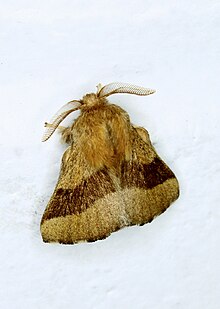Malacosoma disstrium
| Forest tent caterpillar moth | |
|---|---|
 |
|
| adult | |
 |
|
| larva | |
|
Not evaluated (IUCN 3.1)
|
|
| Scientific classification | |
| Kingdom: | Animalia |
| Phylum: | Arthropoda |
| Class: | Insecta |
| Order: | Lepidoptera |
| Family: | Lasiocampidae |
| Genus: | Malacosoma |
| Species: | M. disstria |
| Binomial name | |
|
Malacosoma disstria Hübner, 1820 |
|
| Synonyms | |
|
|
The forest tent caterpillar moth (Malacosoma disstria) is a North American moth found throughout the United States and Canada, especially in the eastern regions.
The larvae of this species are notorious tent caterpillars. Tent caterpillars do not make tents, but rather, weave a silky sheet where they lie together during molting. They lay down strands of silk as they move over branches and then travel along them like tightrope walkers. They follow pheromones secreted by other larvae rather than following the silk lines themselves. The caterpillars are social, traveling together to feed. The caterpillars live in deciduous trees, which they strip off leaves after emerging from their eggs. The adult moth of this species favors oak, sweetgum, tupelo, aspen, and sugar maple for oviposition, but the larvae can be found feeding on many other species of woody trees or shrubs. The females lay eggs in masses of up to 300, which are stuck to twigs and covered with a gluey cement called spumaline, which prevents them from desiccating and freezing. The eggs hatch the following winter.
Forest tent caterpillars are usually just over 2 inches (5 cm) in length, but some have been reported to reach 5 inches. They are black, dark brown, or gray, with blue and faint yellow longitudinal stripes. Each abdominal segment bears a white spot, which are covered with fur-like long setae. The adult moth that emerges after pupation is yellow or tan with a thick, short, furry body. The wingspan is about 1.5 inches (3 cm).
The forest tent caterpillar moth is nocturnal, taking flight soon after nightfall and returning to rest before dawn. It is not known how far an egg-laden female can fly, but there is one credible report of this species flying hundreds of kilometres with the assistance of an unusually strong wind.
...
Wikipedia
